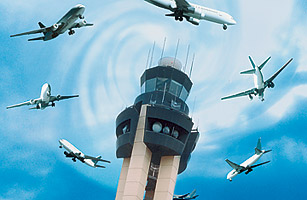
Current air traffic control systems are outdated, relying on repetitive voice communication.
(2 of 2)
A satellite-based system like NextGen will allow for tighter, more direct flight paths — more A to B instead of A to C to B. Every minute cut from a flight plan means fuel saved and carbon emissions averted. And with jet fuel costing about $1.75 per gal. (46 cents per L), that could save the airlines millions.
Much of those savings will come during approach and landing. Because the current system is less precise, controllers need to give planes plenty of room as they lock onto the runway, descending in a slow, stepped approach. NextGen will allow planes to make what is called a continuous-descent approach (CDA), essentially letting them turn off their engines, saving tons of fuel and reducing pollutants. At the airport in Louisville, Ky., where UPS has been experimenting with a satellite-based control system, the shipper has been able to use CDA for landings and maximize the number of planes in the air at any given time. UPS estimates that the system has helped save its planes 250 to 465 lb. (110 to 210 kg) of fuel per flight. "Making engines more efficient isn't easy or cheap," says Bob Smith, chief technology officer of Honeywell Aerospace, whose SmartPath precision-landing system will be part of NextGen. "But improving air-traffic management can be done just by optimizing the technology we already have."
The FAA says that by 2018, as NextGen is rolled out around the U.S., the new system will reduce flight delays 35% to 40% and save almost a billion gallons of fuel. There should be safety benefits as well: in an ADS-B trial in Alaska, the accident rate for planes fell 47%. But the shift won't be cheap: the FAA estimates that NextGen will cost from $15 billion to $22 billion, with a comparable cost for airlines as they outfit their planes with new equipment.
And not every airline expert is convinced that NextGen will live up to the FAA's promises, especially given the agency's management history. Even with a more efficient control system, the most heavily trafficked corridors may remain congested because of sheer lack of runway space. "The satellite-based system is great, but it should have been put in place much earlier," says Mike Boyd, an airline-industry consultant based in Colorado. "I guarantee you, NextGen will not fix the delay problem."
Even if NextGen delivers impressive efficiency gains, the airline industry faces a long-term climate challenge. With global airline-passenger numbers expected to rise more than 6% from now to 2013 — even with a sharp decline this year because of the recession — efficiency improvements may barely compensate for overall growth. If the airline industry is really going to reduce carbon emissions — in September the IATA pledged to cut emissions 50% from 2005 levels by 2050 — it will need to scale up low-carbon biofuels. But aviation is well behind the automotive sector when it comes to viable alternative fuels, and some environmentalists argue that the only sustainable solution is simply to fly less. "Efficiency isn't enough," says Richard Dyer, aviation campaigner for Friends of the Earth. "To go on raising emissions isn't acceptable."
Still, while high-speed trains can reduce the need for some short-haul flights, it's difficult to imagine the aviation sector shrinking. Expect airlines to be big purchasers of greenhouse-gas offsets if a global carbon cap is mandated in Copenhagen, while research continues on alternative fuels. But modernizing an antiquated air-traffic-control system makes sense even if the globe never warms another degree. "Ultimately, this is about a better travel experience over the long term," says John Kefaliotis, ITT's program manager for ADS-B. We've all got better things to do than waste time — and everything else — in the air.